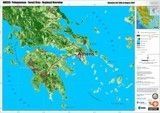PAGE CONTENTS
Objectives
During the past summer periods, forest fires in Greece and in other, mainly southern, EU countries have been quite frequent and devastating particularly due to the vegetation type, climatic conditions and the large percentage of coverage of forest and wooded land areas. On top of these, the specific terrain morphology as well as the vast amount of mountainous and insular regions makes fire detection very difficult. In this context, a very recent and characteristic example is the devastating fires that broke out in the summer of 2007 in Greece (Figure 1).
Figure 1 – Burnt area extracted by Envisat MERIS FR
In view of the above, the SFEDONA project designed, developed, validated and demonstrated a complete end-to-end fire detection and alerting application which makes use of state-of-the-art fire detection technologies based on terrestrial optical cameras and sensors, data fusion, satellite and wireless communications as well as modern IT technologies.
In particular, the SFEDONA project dealt with the design, development, integration and validation of a terrestrial wireless network for the interconnection of various components installed on-field, such as optical and panoramic PTZ cameras, weather monitoring stations and wireless environmental sensors, as well as of a satcom network for the interconnection of the end user’s premises with local field.
The outcome was an integrated system offering a complete, end-to-end fire detection and alerting solution to the interested end users, such as Prefectures, Municipalities and large property owners, with the following services:
- Continuous 24/7, centralized and remote monitoring and control of large areas being prone to (mainly) forest fires.
- Early detection and alert of fire incidents as well as communication of critical data and alerts related to processed inputs received by various on-field cameras and sensors.
- Identification of exact location of fire alert incidents in electronic maps with the aid of an integrated GIS-based user-friendly application.
- Prediction of fire propagation orientation based on sophisticated algorithms and the processing of inputs coming from remote environmental sensors and weather monitoring stations.
Challenges
The key issues addressed in SFEDONA were:
- Accurate and early detection of fire incidents over large geographic areas, mainly forests, which span across even distant mountainous and insular regions as well as rural and suburban areas.
- Local on-the-field processing and fusion of critical data coming from various input sources, such as optical camera sensors, weather monitoring stations and wireless environmental sensors, related to fire detection and alerting.
- Efficient and optimised use of the return link of satcom interface (from local field to end user premises) for the low data rate communication of the already processed critical data and alert.
Plan
The SFEDONA project successfully kicked off on 15th April 2009 with an expected total duration of 15 months. This included an initial 2-month period for user requirements definition and system specification (WP1), a subsequent 2-month period for system design (WP2) and a following 6-month period for system development (WP3), integration and in-lab testing (WP4).
The last 5 months of the project duration were dedicated to the system validation (WP5) through extensive field trials supported by end user organisations. Throughout the overall project period, Commercial Exploitation and Market Monitoring (WP6) were conducted.
Current Status
The SFEDONA project has been successfully completed in line with the initial schedule. Particularly, the SFEDONA project has completed and achieved all the respective review milestones of the baseline design phase (Milestone MR1), detailed design phase (Milestone MR1.5), development, integration and in-lab testing phase (Milestone MR2) as well as all the related field validation activities (Milestone MR3/FR).
Since the project kick-off, the relevant user requirements were defined and the system specifications were accordingly consolidated. In addition, a detailed design of the SFEDONA system and its components were conducted in compliance to the consolidated system specifications and in-lab and field validation tests were defined and elaborated.
Furthermore, all software elements and applications residing within the CC and RCU were developed and the related hardware components of the RDCU, RCU, CC and Satcom Network were carefully selected and procured. A laboratory testbed was also implemented based on which all relevant In-Process Tests (IPT), Integration Tests (IT) and In-House Validation (IHV) tests for both hardware and software components as well as for the overall system itself, were conducted and successfully completed in line with a detailed test plan.
In addition, following a site survey conducted at the end user’s site together with the end user’s consultation, the SFEDONA pilot system was fully deployed, based on which all the related field validation activities were conducted. In particular, all Customer Validation Tests (CVT), incl. a pilot operation phase where the pilot system has been used and operated by the end user, were successfully executed at the end user’s site in line with the defined test plan.
During the pilot period, no actual fire/smoke incident occurred except for those fire/smoke incidents artificially generated in the framework of the CVT tests which were successfully detected by the system. The involved end user has been actively supporting the field validation activities by providing recommendations and feedback with respect to the pilot system’s use and operation. Based on this feedback, a detailed and illustrative User Manual for the SFEDONA system was also elaborated as part of the project deliverables.
The in-lab and field validation activities that were conducted demonstrated that the performance of the SFEDONA pilot system was fully compliant to the System Specifications and User Requirements.
During the project lifetime, the Greek market and the relevant competitive environment in the area of fire detection and alerting was continuously monitored and analyzed. Based on this analysis, a detailed Business Plan for the SFEDONA product was elaborated providing useful figures for its market potential.
Finally, the SFEDONA project disseminated its achievement and results towards other user and scientific communities. In particular, a scientific article on SFEDONA system design and lab validation results was accepted after peer-review for presentation at the international conference “ASMS2010” (www.asms2010.org) whereas the SFEDONA system and advantages have been disseminated at a User Workshop organized in Athens, Greece, which was attended by several end user organizations, falling with the categories of the SFEDONA target customer group.

